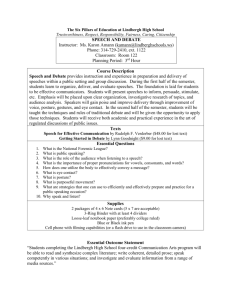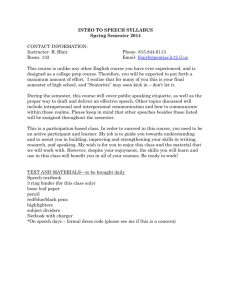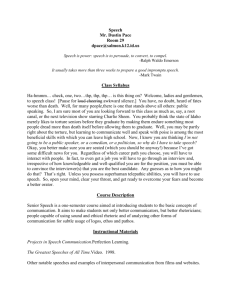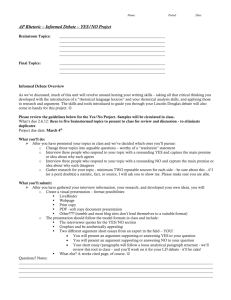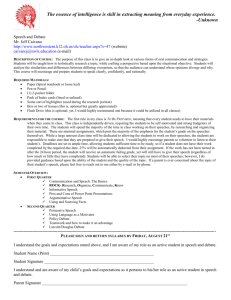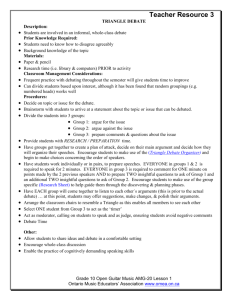Course Statement, Speech - St. Ignatius Public Schools
advertisement
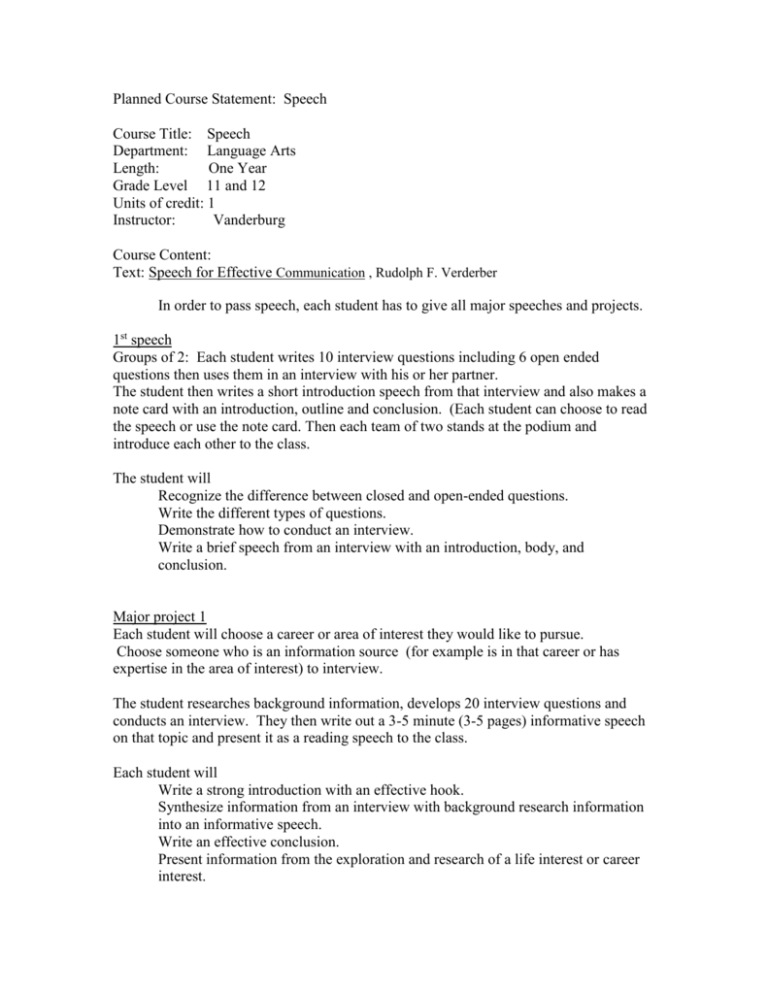
Planned Course Statement: Speech Course Title: Speech Department: Language Arts Length: One Year Grade Level 11 and 12 Units of credit: 1 Instructor: Vanderburg Course Content: Text: Speech for Effective Communication , Rudolph F. Verderber In order to pass speech, each student has to give all major speeches and projects. 1st speech Groups of 2: Each student writes 10 interview questions including 6 open ended questions then uses them in an interview with his or her partner. The student then writes a short introduction speech from that interview and also makes a note card with an introduction, outline and conclusion. (Each student can choose to read the speech or use the note card. Then each team of two stands at the podium and introduce each other to the class. The student will Recognize the difference between closed and open-ended questions. Write the different types of questions. Demonstrate how to conduct an interview. Write a brief speech from an interview with an introduction, body, and conclusion. Major project 1 Each student will choose a career or area of interest they would like to pursue. Choose someone who is an information source (for example is in that career or has expertise in the area of interest) to interview. The student researches background information, develops 20 interview questions and conducts an interview. They then write out a 3-5 minute (3-5 pages) informative speech on that topic and present it as a reading speech to the class. Each student will Write a strong introduction with an effective hook. Synthesize information from an interview with background research information into an informative speech. Write an effective conclusion. Present information from the exploration and research of a life interest or career interest. Speech pg. 2 Major Project 2 Important concepts to review in the chapter: general purpose and specific purpose. Demonstration Speech Each student chooses a skill to demonstrate. Some examples are cook a dish, play an instrument, create an arts project like origami, rope tying, fix something on the car like changing a tire, the oil, demonstrate how to play a sport or do something within that sport, for example, demonstrate how to pitch.. The student does a demonstration or partial demonstration. The speech must include background information. Each student will need a visual to use as an outline showing the steps. This can be used instead of note cards if appropriate to the situation. The speech is a minimum of 7 minutes and no longer than 20. Throughout the year each student will practice and improve on the skills stated in the following goals. Each student will: Speak clearly with good inflection. Establish good eye contact. Use movements and gestures that add to the effectiveness of the speech. Handle note cards and written speeches effectively. Use visuals effectively. Write the following statements: General purpose, specific purpose, and thesis statement. Develop organizational patterns, will recognize and write main points and proof, conclusion, transitional devices. Write speech outlines and use them to building effective note cards. Short Speeches for practice throughout 1st semester: As part of the review of concepts for each major speech and project, the students prepare and present short speeches that illustrate and give the students a chance to practice skills taught in the text chapters. Examples: Find a joke appropriate to read to the class. Using a note card with an introduction, outline and conclusion, tell a ghost story or a story about something strange or unusual. Informal Speaking Throughout 1st semester, before the demonstration speech, the students also participate in class discussions or scenarios about issues important to them or issues they will face in the real world. This year, 2001, for example, we discussed vandalism of a student’s backpack in class, and the September 11 events. Last year we did scenarios of meetings, court cases. Speech pg. 3 Each student will demonstrate good informal speaking and listening skills in the following ways: Speaking his or her opinion to a group on an issue pertinent to the students informally and without preparation. Listening to the opinions of others in a respectful way and giving feedback. Working as a member of a group to come to compromise or consensus. 1st Semester Test First activity: class and group prewriting brainstorm sessions on the concepts from the chapters covered 1st semester, and the main skills, goals, and objectives within each speech and project speech given 1st semester. The students take notes. On semester test day, they are to bring those notes to class. They are to write a 3minute speech (essay – and it is very important that they understand a speech is an orally delivered essay). This speech must be at least 3 written pages long. The topic is, “What I have learned in speech first semester.” They get points for organization, for specific information and for using their own and other students’ speeches as examples. When they complete their essay, they are to read through it, making corrections and additions in clarity, information, and conventions. Major project 3: Divide into groups. Choose a section from a comic book. Do a reading presentation to the class, emphasis using voice and movement to become the character in their readings. Each group evaluates another group. In evaluations, the students in each group will: Give positive written feedback using specific evidence from the speech or presentation in the student evaluation. Give positive written suggestions using specific evidence in the student evaluation. In the presentations, each student will: Pronounce all words correctly. Use voice pitch and volume to convey each character and the emotion and meaning of the selections. Work together effectively for dialogue flow. Use unique ways of introducing and enhancing the presentation. Give positive evaluation and suggestions for improvement that relate specifically to the presentation each evaluates. Major project 4: Important concept: To read prose and poetry for meaning, especially, in the case of poetry, not for rhythm or rhyme. Choose two poetry selections and two prose selections. Turn them into the teacher for evaluation. Speech, pg. 4 Each student will use one selection for practice and one for final performance from each type. In groups of two, practice and perform each practice piece, one prose, one poem. Give the practice presentation to your partner, he or she evaluates you. (Advanced alternative – dramatic presentation of a play scene.) You perform your final for each type to the class. Each student self evaluates his or her own presentation. Each student will: Pronounce each word correctly and show by the reading of the piece that he or she understands the meaning of the vocabulary and the piece.. Use voice support, pitch, and volume to convey the meaning and emotional tone of the piece. Read each piece in a way that effectively conveys the meaning. Give positive evaluation and helpful suggestions that pertain specifically to the piece being evaluated. Write a self – evaluation that shows an awareness of the best aspects of his or her reading and areas that need to be improved. Major Project 5, Debate Brainstorm debate topics that are of current interest to students. Discuss resolution. Explain that in a debate the affirmative and negative are arguing about the resolution (proposition), not just the topic. In order to have a debate there needs to be good issues both for and against. To determine that they see two sides clearly and are able to argue both sides, write resolutions with their input. Students are assigned to teams to debate resolutions and determine affirmative and negative speakers. Groups of two or groups of four in a traditional team -of- two debate format. If time, the class is allowed to question sides after the debate – points for good questions. An individual who misses his or her debate will present his or her constructive speech to the class and debater in a question/ answer session for full points if an emergency, for C or below grade if not an emergency. 1st assignment in Debate Turn in 5-7 pages written constructive speech Constructive speeches for the debate, both affirmative and negative, will be written out, 5 to 7 minutes (pages) long. Check to see that there is (1) A good hook. (2) A strong thesis statement that is the resolution restated to express the student’s side. (3) Three strong main points using logical reasoning. (4) Valid, strong proof that backs those points and is documented. 2nd Debate assignment: practice rebuttals in class on discussion issues. Speech, pg. 5 Present Debates Student evaluations Student and teacher evaluations used to determine winners for Debate Certificates. Each student will Write and read a 5-7 minute constructive debate speech/persuasive speech with an introduction that clearly states the argument, a body with at least three main points and documented proof that lays out the argument, and a strong conclusion that ties the argument together. Take notes during the opposing side’s speech or speeches and construct a rebuttal speech 3-5 minutes long that answers the opposing argument and reinforces his or her own. Evaluate the clarity and strength of other arguments based on specific observations from those specific arguments. Read each speech with appropriate voice, pitch, emotion and gestures to support and enhance the meaning and emotion of each speech. Major Project 5 “Reading in the Real World” Choose a children’s book, grade appropriate, to read to a group of young students. Groups of 2: One student reads while the other student evaluates. Each student has an appointment to read his or her book to a head start, day care, or grade school class. Classes can be divided into groups of two or three, so two to three teams can go to one class for a reading period. Day one, one student reads, the other evaluates. The next day, the individuals in each team switch roles. Each student will Choose and read a story appropriate to the audience. Use voice tone and pitch to convey the characters and the story to the audience. Display the book and pictures to enhance the reading. Evaluate another students reading positively and constructively with specific details from that presentation. Final Project: A 5 to7 page speech, using a Power Point Project of at least 5 slides. A suggestion is one slide for every page or point. Subject: “My Life, Reality and Fantasy” Speech, pg. 6 Final Speech content: The students present life plans including what they have done so far to insure their plans and what they will do, a budget for success, an education or training plan, jobs they have done and/or could do to get to their careers, and different careers they are interested in pursuing including people they have talked to about those jobs – they can use information from 1st quarter’s interview speech. Fantasies can include pictures of the home they’d like to have, the car or cars, and property - include the price and how they propose to get the money. Their fantasies can also include places they’d like to go, why they’d like to go there (they must research this part to make sure they can talk about everything they could do there.) They can cover, what hobbies they have now that they will develop or what hobbies, adventures or challenges they’d like to pursue if they had the time, opportunity, or money. They can also include their families, for example, what kind of parent and husband or wife they would like to be. What shared interests they would like to have and how they would like to support the other members of their families, solve problems, and develop good relationships. They can include their life philosophies and beliefs. Each student will Demonstrate the effective use of PowerPoint as a visual aide in a speech. 2nd Semester Test: A written test similar to first semester only covering the topics and text book chapters covered in 2nd semester and reviewing the basics of 1st semester. Alternative: All students who have received A’s all four quarters can give a speech 5 minutes long on a topic they feel strongly about. They need to discuss this topic at least two weeks ahead of time with the teacher and set a time to present it to the class. In accordance with the Montana Standards for Speaking and Listening, the students will Content Standard 1 – demonstrate knowledge and understanding of the communication process. Content Standard 2 – distinguish among and use appropriate types of speaking and listening for a variety of purposes. Content Standard 3 – apply a range of skills and strategies to speaking and listening. Content Standard 4 – identify, analyze, and evaluate the impacts of effective speaking and evaluate listening. In accordance with the Montana Standards for Writing the students will: Content Standard 1: Write clearly and effectively. Content Standard 2: Apply a range of skills and strategies in the writing process. Content Standard 3: Write for a variety of purposes and audiences. Content Standard 5: Recognize the structures of various forms and apply these. Content Standard 6: Use the inquiry process, problem-solving strategies, and resources to synthesize and communicate information. Media Literacy The student will demonstrate the use of grade-level media/technology literacy skills in computer research for speeches and in creating and presenting his or her power point presentation. Career Development – The student will demonstrate the use of career development skills in the interview major speech project 1, as part of the demonstration speech, and in the final speech project, (education, training and career information.) Native American Studies (House Bill 528) Students will be given access to prose and poetry by Native American authors for their readings. Students will be encouraged to do career research with SKC materials and use SK Tribal resources for career searches and interviews. They will also be encouraged to share cultural information and skills in the demonstration speeches and in other speeches throughout the year.
